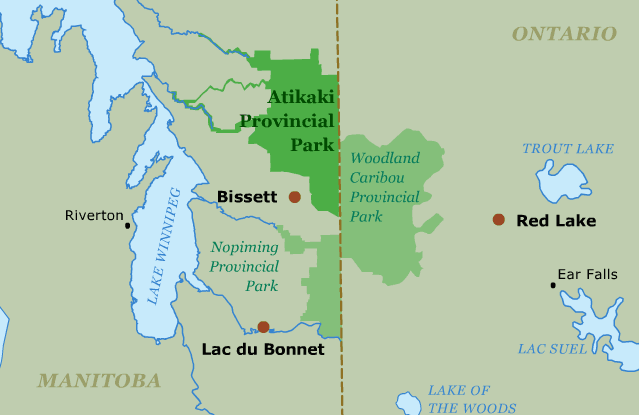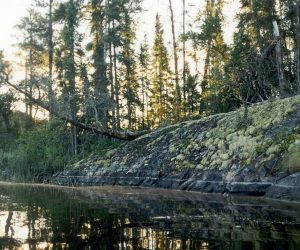Atikaki Provincial Wilderness Park is known for the Bloodvein River, a Canadian Heritage River, but with 1 million acres (400,000 ha) contiguous to Woodland Caribou Park in Ontario, there are many other lakes and rivers on their way to Lake Winnipeg to explore. Traveling the ancient waterways you may see pictographs and the caribou that brought their makers into Atikaki, Ojibwe for “the country of the caribou.” Today there are still no roads into Atikaki, but you can paddle in or fly in from Bissett, Riverton, or Lac du Bonnet. Atikaki has no designated campsites, but does have several backcountry lodges that were established before the land was designated a provincial park. No matter how you get there, Atikaki offers adventure and challenge for paddlers ready for a remote wilderness.

Jump-off Points:
 Park & Permit Info
Park & Permit Info
Atikaki is designated as a “Wilderness Park” in the Manitoba Provincial Parks system. As such, no camping fees are assessed. The 1,500-plus square mile park offers fantastic lake and river paddling and–combined with its sister Woodland Caribou Provincial Park to the east in Ontario–offers a vast wilderness to explore and admire.
Manitoba Conservation: Atikaki
 Fire Information
Fire Information
Travelers in the park can find up-to-the-minute information on wildfires via the Manitoba Conservation Fire Program web page.
Manitoba Conservation: Fire Program
 Maps & Routes
Maps & Routes
There’s no guidebook for the area, so plan on guiding yourself via topographical maps, maps available via the Manitoba government maps store, or with advice from local outfitters or park officials. The park offers a map suitable for trip planning online.
The Bloodvein River, a Canadian Heritage River, offers a classic, natural route through the park. Beginning in Ontario’s Woodland Caribou Provincial Park, the rock-studded, pictograph-decorated route ultimately descends to the northern end of Lake Winnipeg.
Maptown: Canadian Topographical Maps
Manitoba Conservation: Atikaki Map [PDF]
Canadian Heritage Rivers System: Bloodvein River
 History
History
The area was designated a provincial park in 1985. Its purpose is to preserve physical features and biological communities of the Lac Seul Uplands. Archaeological evidence says a succession of aboriginal peoples occupied the area, making a life via seasonal rounds through the territory.
 Ecology
Ecology
Atikaki contains some of Canada’s oldest rock, formed about three billion years ago. Once part of a mountain range, it was reduced to a relatively flat plain by wind, precipitation, and changes in temperature. Several glaciers sculpted the remaining surfaces to form the base of today’s blue lakes and green forests.
Atikaki composes about 50% of the Atikaki-Berens Woodland Caribou Range, which is home to an estimated 300-500 of the reclusive animals. Atikaki’s boreal forest features black spruce, jack pine, aspen, and balsam poplar along with stands of white birch, white spruce and balsam fir.
 Fishing
Fishing
Fishing for northern and walleye pike and trout is a popular pursuit in Atikaki. Anglers must possess a valid Manitoba fishing license and observe provincial laws and limits.









